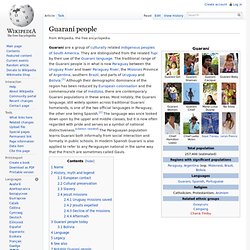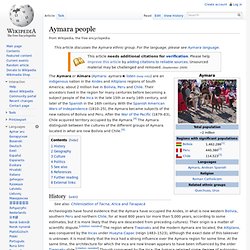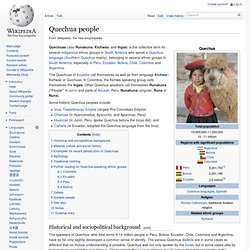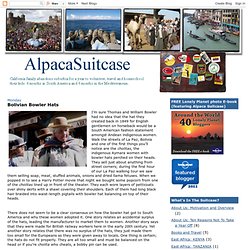

Guaraní people. Guaraní are a group of culturally related indigenous peoples of South America.

They are distinguished from the related Tupi by their use of the Guaraní language. The traditional range of the Guaraní people is in what is now Paraguay between the Uruguay River and lower Paraguay River, the Misiones Province of Argentina, southern Brazil, and parts of Uruguay and Bolivia.[1] Although their demographic dominance of the region has been reduced by European colonisation and the commensurate rise of mestizos, there are contemporary Guaraní populations in these areas. Most notably, the Guarani language, still widely spoken across traditional Guaraní homelands, is one of the two official languages in Paraguay, the other one being Spanish.[2] The language was once looked down upon by the upper and middle classes, but it is now often regarded with pride and serves as a symbol of national distinctiveness.
Name[edit] Aymara people. The Aymara or Aimara (Aymara: aymara listen ) are an indigenous nation in the Andes and Altiplano regions of South America; about 2 million live in Bolivia, Peru and Chile.

Their ancestors lived in the region for many centuries before becoming a subject people of the Inca in the late 15th or early 16th century, and later of the Spanish in the 16th century. With the Spanish American Wars of Independence (1810–25), the Aymara became subjects of the new nations of Bolivia and Peru. After the War of the Pacific (1879–83), Chile acquired territory occupied by the Aymara.[4] The Aymara distinguish between the cultures of the different groups of Aymara located in what are now Bolivia and Chile.[4] History[edit] Linguists have learned that Aymara was once spoken much further north, at least as far north as central Peru. Quechua people. Quechuas (also Runakuna, Kichwas, and Ingas) is the collective term for several indigenous ethnic groups in South America who speak a Quechua language (Southern Quechua mainly), belonging to several ethnic groups in South America, especially in Peru, Ecuador, Bolivia, Chile, Colombia and Argentina.

The Quechuas of Ecuador call themselves as well as their language Kichwa–Kichwas or Quichuas. In Colombia, the Kichwa-speaking group calls themselves the Ingas. Other Quechua speakers call themselves Runakuna ("People"' in Junín and parts of Ancash, Peru: Nunakuna; singular: Runa or Nuna). Some historic Quechua peoples include: Inca; Tawantinsuyu Empire (largest Pre-Columbian Empire)Chancas (in Huancavelica, Ayacucho, and Apurímac, Peru);Huancas (in Junín, Peru; spoke Quechua before the Incas did); andCañaris (in Ecuador; adopted the Quechua language from the Inca). Historical and sociopolitical background[edit] Material culture and social history[edit] Quechua woman with children Mythology[edit] Bowler hat. American photographer and filmmaker Paul Strand wearing a bowler hat in 1916.

History[edit] The bowler once defined British civil servants and bankers, and later American workingmen.[4] It was devised in 1849 by the London hat-makers Thomas and William Bowler to fulfill an order placed by the firm of hatters Lock & Co. of St James's.[4] Lock & Co. had been commissioned by a customer to design a close-fitting, low-crowned hat to protect Coke's gamekeepers' heads from low-hanging branches while on horseback. The keepers had previously worn top hats, which were easily knocked off and damaged. Bolivian Bowler Hats. I’m sure Thomas and William Bowler had no idea that the hat they created back in 1849 for English gentlemen on horseback would be a South American fashion statement amongst Andean indigenous women.

Walk the streets of La Paz, Bolivia and one of the first things you’ll notice are the cholitas, the indigenous Aymara women with bowler hats perched on their heads. They sell just about anything from street corners; during the first hour of our La Paz walking tour we saw them selling soap, meat, stuffed animals, onions and dried llama fetuses. When we popped in to see a Harry Potter movie that night we bought some popcorn from one of the cholitas lined up in front of the theater. They each wore layers of petticoats over shiny skirts with a shawl covering their shoulders. Each of them had long black hair braided into waist-length pigtails with bowler hat balancing on top of their heads.
Bolivia-6.jpg (1800×1200) Landscapes Wallpapers Gallery.